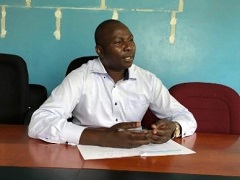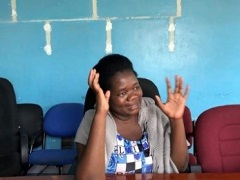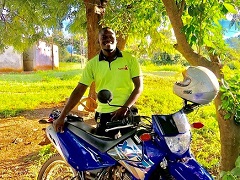- Home
- Technical Cooperation Projects
- Index of Countries
- Africa
- Zambia
- The Project for strengthening Basic Health Care Services Management for Universal Health Coverage (BHC for UHC Project)
- Project News
- DSAP approach 2: Strengthening the TB sample referral system in Choma
Project News
2019-07-01
DSAP approach 2: Strengthening the TB sample referral system in Choma
In Zambia, tuberculosis (TB) is the leading cause of death among people living with HIV/AIDS.[1] In this country, about 18,000 people died of TB (including infections due to HIV/AIDS) in 2017.[2] A particular problem in Zambia is the fact that many patients with TB have not been diagnosed, hence not treated. While diagnostic technology for TB has been in place, one of the major obstacles would be that suspected TB patients do not reach health facilities for testing.
The Project supports linking suspected TB patients with early diagnosis and treatment. The bike riders, who are stationed at the hub health centre, transport sputum samples of suspected TB patients from a health centre or health post to health facilities where TB can be diagnosed. In the past, patients who could not be tested at a nearby health centre or health post had to go to a distant diagnostic facility for a definitive diagnosis. Now, only the samples can be transported for diagnosis, making it easier for local residents to receive TB testing. With support from the Project, the TB sample referral system has started. The number of samples referred has increased 43 times in a year.
Mr Austin Muchanga, Senior Clinical Officer, and Ms Naomi Tembo, TB and HIV/AIDS Coordinator, in Choma District, one of the Project sites, both mentioned that the introduction of the TB sample referral system has dramatically increased the number of TB diagnoses. The Project provided healthcare workers and bike riders with the training on the concept of biosafety, means of sample transport, and maintenance method of motorcycles. Mr Muchanga says, "I hope not only healthcare workers but also the riders will be responsible for completing their duties so that the TB diagnosis of each patient will not be delayed."
"The patient is treated for about six months after being diagnosed with TB. But it is necessary to look at the sample again and again to confirm that the TB bacteria have disappeared. The TB sample referral system certainly mediates a barrier for TB patients to continue treatment and cure," saysMs Tembo.
One straight road is paved on the vast land of Zambia. From there, turn to the side road and continue a muddy, bumpy road full of red soil and greens, there you will find Mapanza District. Mr Nathan Mwansa, who transports samples based at Mapanza Health Centre, does this job with a sense of mission. This hub health centre covers two other health centres and three health posts. Sputum samples are collected from each facility twice a week and transported about 30 km away to Macha Hospital, where diagnostic equipment is available.
Mr Mwansa says, "If I get samples from all the covered facilities, I will ride alone on a bad road over 100 km, which takes about 5 to 6 hours." He continues, "Sample sputum has to be fresh for proper diagnoses with TB. There is no such thing as a refrigerator to keep the proper temperature here. So, I may go for collection even if it is not the fixed day of the week whenever the sample arrives. We are prepared to go at any time so that we will not miss the visit of the suspected TB patients."
 Mr Austin Muchanga, Choma District Health Office
Mr Austin Muchanga, Choma District Health Office
 Ms Naomi Tembo, Choma District Health Office
Ms Naomi Tembo, Choma District Health Office
 Mr Nathan Mwansa, Mapanza Health Centre
Mr Nathan Mwansa, Mapanza Health Centre
Notes
- [1] CDC in Zambia, https://www.cdc.gov/globalhealth/countries/zambia/pdf/Zambia_Factsheet.pdf 2015
- [2] WHO Tuberculosis country profiles in Zambia. Generated: 2019-02-11
- About JICA
- News & Features
- Countries & Regions
- Our Work
- Thematic Issues
- Types of Assistance
- Partnerships with Other Development Partners
- Climate Change / Environmental and Social Considerations
- Evaluations
- Compliance and Anti-corruption
- Science and Technology Cooperation on Global Issues
- Research
- JICA Development Studies Program / JICA Chair
- Support for the Acceptance of Foreign HRs / Multicultural and Inclusive Community
- Publications
- Investor Relations
